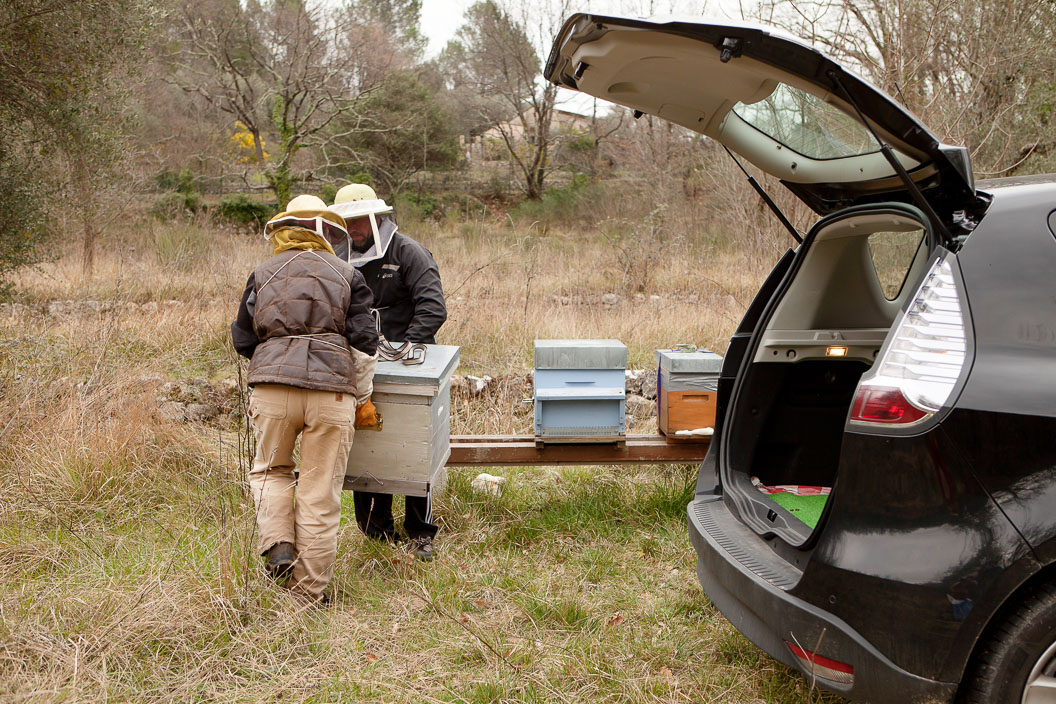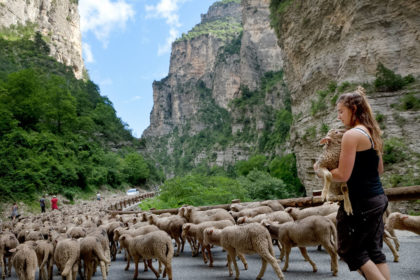Driving around with a car full of bees isn’t my idea of fun, especially navigating hairpin bends in the snowy mountains high above the French Riviera. But one crisp morning this February, beekeeper Amanda Dowd did exactly this, for a very good reason (with me, the photographer, following behind… at a safe distance).
Bee warrior – and a new invader
Amanda is a cottage beekeeper, with 12 hives of her own. Honeybees arguably need all the help they can get these days, in the face of pesticides, disease and habitat loss, and Amanda is also something of a bee warrior in her South of France neighbourhood. If a swarm of bees decides to shack up where they are not welcome, she is the woman to call. Amanda will drop everything, don a protective suit and veil, and speed over to move the swarm and save the bees before the pest control people arrive.
Since last summer though, Amanda has been preoccupied by the plight of her own honeybees. The recent arrival of Vespa velutina (or Asian hornet, as it is better known) to France is posing a very serious threat to the existence of bees across the country. The first few Asian hornets sneaked into southwest France on a ship in 2004. Doubtless delighted to discover that they had no natural predators here, they settled in. Each nest of Asian hornets can raise thousands of workers. More importantly, however, up to 300 larvae in the nest have the potential to be queens, who can then go off alone and set up a new home somewhere else. The population of Asian hornets in France (and now in neighbouring countries) has expanded at an astonishing rate. They flourish in the South of France, where the length of the warm summer season has always been a plus for expatriates.
Critical siege situation
Asian Hornets made it to the Cote d’Azur in 2010, and there haven’t been enough of them to be a problem – until last summer. Then even I, ignorant of the new invader and with no particular interest in bees, felt concerned by the number of apparently supersize wasps flying about, in an apparently irritable quest for beer and jam.
I have since learned that what Asian hornets actually like best of all is chomping on bees, with some pollen for dessert. When adult hornets find a beehive, they employ the cunning tactic of simply hovering right in front of the door until a bee comes out, at which point they rip off its head and wings and gobble it down, or take it back to the nest, where they throw it to the larvae and tell all their mates where they found it.
Over in a wooded valley between Vence and Grasse where Amanda kept her hives, Asian hornets were suddenly everywhere. Her honeybees were simply doing what you or I would do – no longer going out. The poor bees that had made it out between hornet relays, and spent hours loading themselves up with pollen to bring back to the hive, couldn’t get back in the door, and were perfect snacks for hornets. No pollen in a hive means no honey. When there isn’t enough honey to feed new baby bees, the queen will stop laying eggs and the population of a hive can die out in the space of a few weeks. One local survey of beekeepers in and around Cagnes-sur-Mer (on the coast between Nice and Antibes) concluded that over 50% of beehives were lost as a result of Asian hornets last summer.
Emergency relocation of hives
Amanda drove herself to distraction in a personal war with the hornets. Traps placed around the hives were catching several hundred of these hungry predators a day; others she tried to kill with her (gloved, bound up in rolls of electrical tape) hands. But she was still fighting a losing battle, and did what many beekeepers on the French Riviera have had to resort to: she moved her hives up to higher altitudes where the hornets haven’t yet arrived. Amanda filled her car with hives and drove for over 40 kilometres to a field near Seranon, a village in the Alps over 1000m above sea level, where her bees could at last be free of hornet attacks. (As an aside, you might also like to read another blog post about my day as the photographer of a South of France shepherd, who also conducts a seasonal transhumance – and who too is trying desperately to keep his sheep safe from invaders. Except that in his case the invaders are wolves, not hornets…).
Early snowfall meant that her bees ended up overwintering in the mountains and it wasn’t until February that the snow had melted enough to get access to the hives. I joined Amanda to photograph her moving the bees back down to the valley, so that they could start collecting pollen from the spring flowers already in bloom at lower altitudes, before the new baby Asian hornets hatch out later in the summer. Presumably, when this happens, Amanda will have to bring her hives up to the mountains again, out of reach of the hornets – for the time being.
Franco-Italian beekeeping crisis summit
I can’t say I felt especially comfortable photographing her work. Apart from the unnerving, omnipresent buzzing of disturbed bees, a beekeeper’s veil is not designed with the needs of a photographer in mind. But this bee drama seems to have drawn me in anyway.
A few weeks after the bee relocation, I found myself attending an emergency beekeeper event in Nice. Italian beekeepers spotted the first Asian hornet ever seen in the country in July last year, and they haven’t wasted time in organising a rearguard action. A coachload of concerned beekeepers arrived from Italy to learn more about the enemy from their French counterparts, who were only too happy to share. Extravagant gestures filled in any gaps in vocabulary and, as I watched design after elaborate design of hornet trap being projected onto the wall, I started to feel passionately that I too wanted to be a warrior in this war. Before I knew it, I was taking down the number of an enthusiastic, self-acclaimed expert in hornet nest destruction who invited me to photograph a forthcoming ‘operation’.
But, I’m not sure that photographing this will be a good idea – not particularly easy, safe or enjoyable. Not only do these creatures often nest in the tops of very tall trees, they are apparently also far more aggressive towards intruders than their European hornet cousin. Operation teams have to wear extra-special, super-thick protective clothing, and (especially challenging from a photographer’s point of view) work in the dark, when the insects are at their least active.


